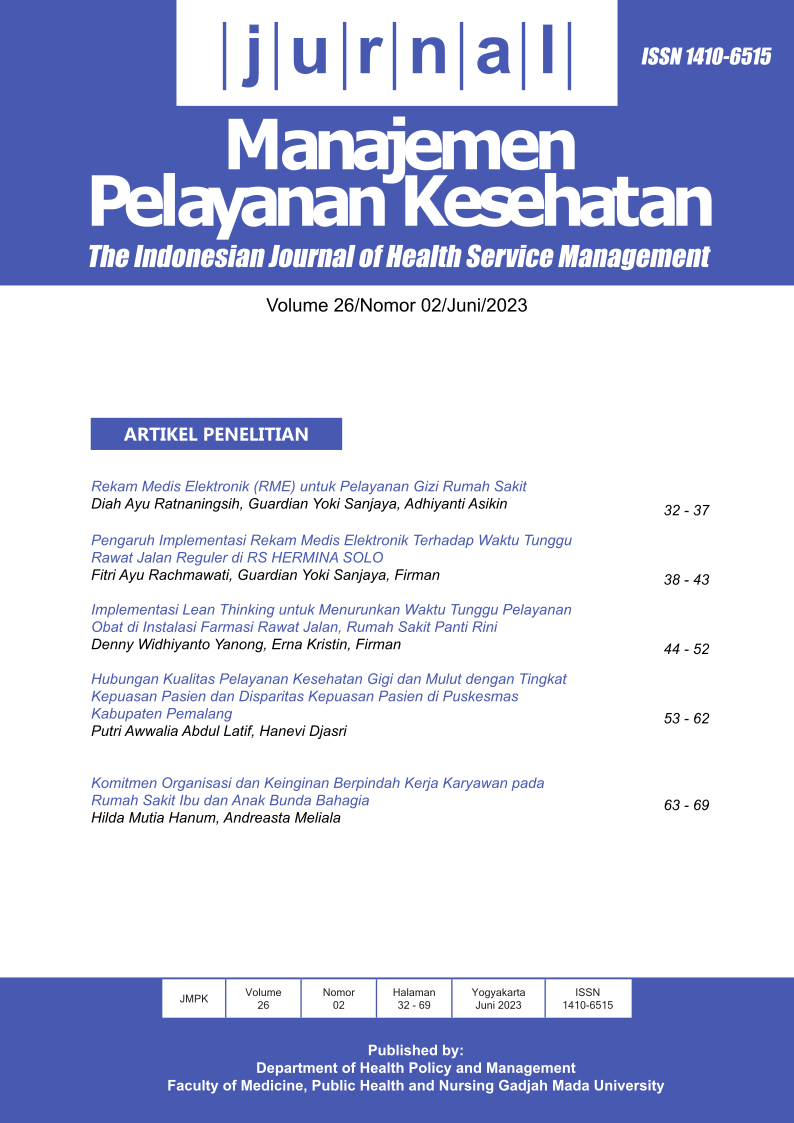PENGARUH IMPLEMENTASI REKAM MEDIS ELEKTRONIK TERHADAP WAKTU TUNGGU RAWAT JALAN REGULER DI RS HERMINA SOLO
Abstract
Background: Patient complaints related to the long waiting time for medical record files in the outpatient installation of regular polyclinics at Hermina Solo Hospital increased from January to June 2022, and the average patient waiting time was 3 hours and 30 minutes in the same period.
There were delays in sending patient data. There are medical record files that are not found during searches and cause doctor complaints; these also impact doctor services related to illegible data or writing, which risks causing patient safety incidents. Objectives: The general objective of this study was to identify the effect of electronic medical record implementation on polyclinic outpatient waiting times. The specific objectives were to identify the effect of electronic medical records on waiting time, waiting time for doctor’s examination, and waiting time for drugs at the pharmacy.Methods: This quantitative research with an analytic observational design through a retrospective cohort approach using the t-test. With the stratified random sampling method, the number of samples before 207 and after 207 samples were carried out from May 2, 2023, to June 5, 2023, at Hermina Solo Hospital in 12 outpatient examination rooms. The research variables were total outpatient waiting time, pharmacy waiting time, and doctor waiting time.Results: Total waiting time after EMR implementation is better than before, namely before 200,21 minutes after 140,87 minutes (p-value 0.000<0.05). Waiting time for doctors before 97,96 minutes and after 88,30 minutes (p-value 0.000<0.05) and waiting time for pharmaceutical services before 72,42 minutes and after 66,97 minutes (p-value 0.035<0.05). The results of the t-test statistical test showed that the effect of EMR on waiting time was significant. Ophthalmologic, urology, orthopedic, and dental departments have a longer waiting time, averaging 105,64 minutes. Conclusion: EMR reduces total outpatient waiting time for doctors and pharmacies. The effect of EMR implementation in outpatient can reduce the number of complaints and increase patient satisfaction.
References
Kementerian Kesehatan Republik Indonesia. Peraturan Menteri
Kesehatan Republik Indonesia Nomor 24 Tahun 2022 Tentang Rekam Medis. 2022.
Nguyen, S. T. T. et al. Waiting time in the outpatient clinic at a national hospital in Vietnam. Nagoya Journal of Medical Science.
;80(2), pp. 227–239. doi: 10.18999/nagjms.80.2.227.
Gopidasan, B., Amanullah, S. and Adebowale. A. Electronic medical records – A review of cost-effectiveness, efficiency,
quality of care, and usability. Journal of Psychiatry Spectrum, 2022;1(2), p. 76. doi: 10.4103/jopsys.jopsys_17_22.
Biya, M. et al. Waiting time and its associated factors in patients presenting to outpatient departments at Public Hospitals of Jimma Zone, Southwest Ethiopia. BMC Health Services Research.
;22(1), pp. 1–8. doi: 10.1186/s12913-022-07502-8.
Creswell, John W. Research Design (Pendekatan Kualitatif, Kuantitatif, dan Mixed). Yogyakarta: Pustaka Pelajar. 2009.
Sugiyono. Metode Penelitian Kuantitatif, Kualitatif, dan R&D. Bandung : Alfabeta. 2017.
Utarini, A. Prinsip dan Aplikasi Untuk manajemen Rumah Sakit.196-197. In Gadjah Mada University Press. https://play.
google.com/books/reader?id=QPrqDwAAQBAJ&pg=GBS.PR7&hl=en. 2021.
Albagmi, S. The effectiveness of RME implementation regarding reducing documentation errors and waiting time for patients
in outpatient clinics: A systematic review. F1000Research, 2021;10, pp. 1–18. doi: 10.12688/f1000research.45039.2.
Luigi. Implementasi Rekam Medis Elektronik Pelayanan Rawat Jalan Di Puskesmas Kecamatan Cilandak’, pp. 45–46.
Available at: http://etd.repository.ugm.ac.id/index.php?mod=-book_detail&sub=BookDetail&act=view&typ=htmlext&buku_
id=131682&obyek_id=4&unitid=&jenis_id=. 2016.
Nurfitria, B., Rania, F. and Rahmadiani, N. W. Literature Review: Implementasi Rekam Medis Elektronik di Institusi Pelayanan
Kesehatan di Indonesia. 2022;10.p. 2.
Tsai, C. H. et al. Effects of electronic health record implementation and barriers to adoption and use: A scoping review and
qualitative analysis of the content. International Journal of Medical Informatics, 2020;10(3), pp. 1–27. doi: 10.3390/life10120327.
Weni, I., Aryani, R. and Saputra, E. Web-Based Electronic Medical Record (RME) Information System to Improve the Quality
of Patient Diagnostic Results’, JUSS: Jurnal Sains dan Sistem Informasi, 2018. 1(1), pp. 56–66.
Copyright (c) 2023 fitri ayu rachmawati

This work is licensed under a Creative Commons Attribution-NonCommercial-ShareAlike 4.0 International License.




